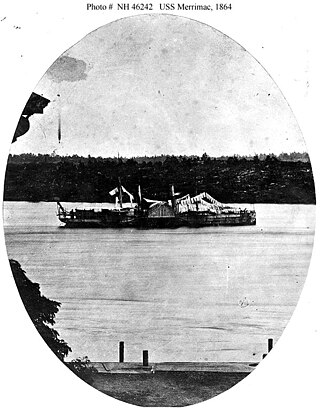The second USS Florida was a sidewheel steamer in the United States Navy.
The first USS Sonoma was a sidewheel gunboat that served in the United States Navy during the American Civil War. She was named for Sonoma Creek in northern California, Sonoma County, California, and the town of Sonoma, California, that in turn were named for one of the chiefs of the Chocuyen Indians of that region.

The first USS Pawnee was a sloop-of-war in the United States Navy during the American Civil War. She was named for the Pawnee Indian tribe.

USS Hendrick Hudson was a schooner-rigged screw steamer captured by the Union Navy during the American Civil War. She was used by the Navy as a gunboat in support of the Union blockade of the ports of the Confederate States of America.

USS Stars and Stripes was a 407-ton steamer acquired by the U.S. Navy and put to use by the Union during the American Civil War.

The first USS Pocahontas, a screw steamer built at Medford, Massachusetts in 1852 as City of Boston, and purchased by the Navy at Boston, Massachusetts on 20 March 1855, was the first United States Navy ship to be named for Pocahontas, the Algonquian wife of Virginia colonist John Rolfe. She was originally commissioned as USS Despatch – the second U.S. Navy ship of that name – on 17 January 1856, with Lieutenant T. M. Crossan in command, and was recommissioned and renamed in 1860, seeing action in the American Civil War. As Pocahontas, one of her junior officers was Alfred Thayer Mahan, who would later achieve international fame as a military writer and theorist of naval power.

USS Merrimac was a sidewheel steamer first used in the Confederate States Navy that was captured and used in the United States Navy during the American Civil War.
The second USS Kensington was a steamship in the United States Navy.
USS Honduras was a steamer acquired by the Union Navy during the American Civil War.

USS Huntsville was a steamer acquired by the Union Navy during the American Civil War. She was used by the Navy to patrol navigable waterways of the Confederacy to prevent the South from trading with other countries.
USS Restless was a barque acquired by the Union Navy during the American Civil War.
USS Fort Morgan was a steamer acquired by the Union Navy during the American Civil War. She was used by the Navy as a storeship and in other minor roles.
USS Magnolia was a steamer captured by the Union Navy during the American Civil War. She was planned to be used by the Union Navy to patrol navigable waterways of the Confederacy to prevent the South from trading with other countries.

The first USS Emma was a steamer captured by the Union Navy during the American Civil War. She was used by the Union Navy as a picket and patrol vessel on Confederate waterways.
USS James S. Chambers was a schooner acquired by the Union Navy during the American Civil War. She was used by the Union Navy as a gunboat in support of the Union Navy blockade of Confederate waterways.
USS Arkansas was a steamer acquired by the Union Navy during the American Civil War. She was used by the Union Navy as a supply ship and tender in support of the Union Navy blockade of Confederate waterways.
USS Augusta Dinsmore was a steamer acquired by the Union Navy during the American Civil War. She was used by the Union Navy as a gunboat in support of the Union naval blockade of Confederate waterways. Because of her relatively large size, she was also sometimes used as a cargo ship.

The first USS Wanderer was a high-speed schooner originally built for pleasure. It was used in 1858 to illegally import slaves from Africa. It was seized for service with the United States Navy during the American Civil War. In U.S. Navy service from 1861 to 1865, and under outright U.S. Navy ownership from 1863 to 1865, she was used by the Union Navy as a gunboat, as a tender, and as a hospital ship. She was decommissioned, put into merchant use, and lost off Cuba in 1871.
USS Glasgow was originally a British cross-Channel sidewheel steamer named Eugenie owned by the South Eastern Railway that was built during the early 1860s. She was sold for blockade-running duties in 1863 and was captured by the Union Navy later that year during the American Civil War. Incorporated into the Navy, she was principally used as a dispatch boat and storeship in support of the Union blockade of the ports of the Confederate States of America. Renamed Glasgow in 1864, she sank after striking an obstacle the following year, but was refloated and repaired. The ship was sold back into commercial service in 1869 and was scrapped 20 years later.
The third USS Union was a heavy (1,114-ton) steamer with a powerful 12-inch rifled gun purchased by the United States Navy during the American Civil War.








